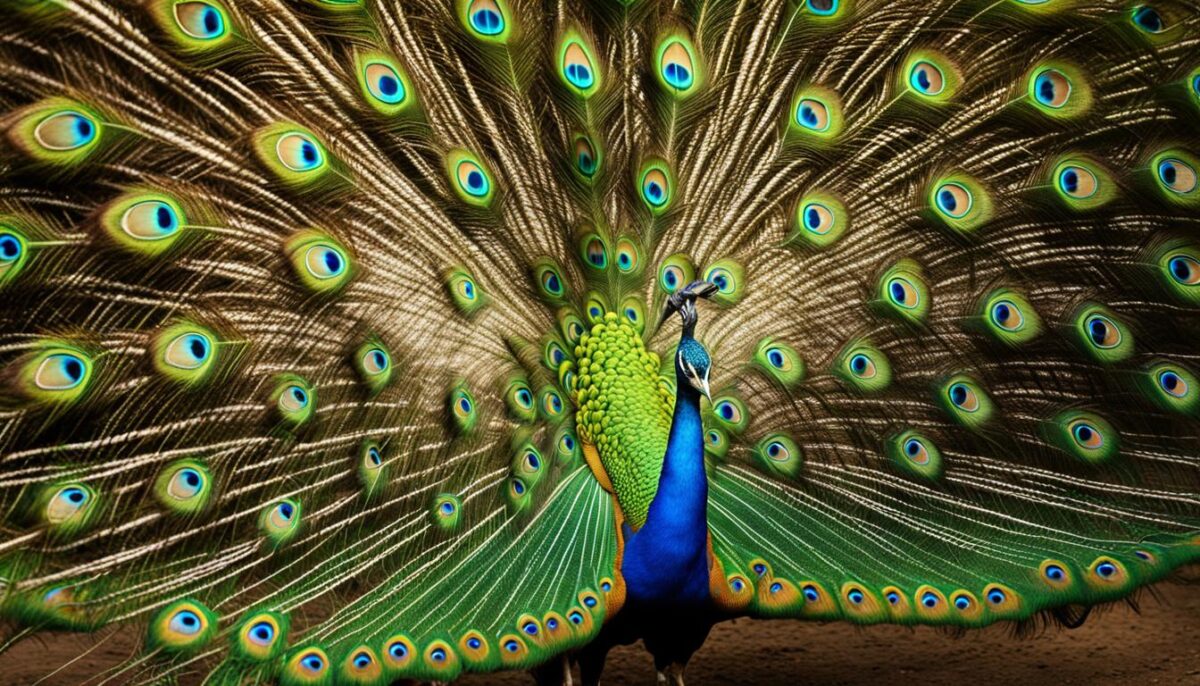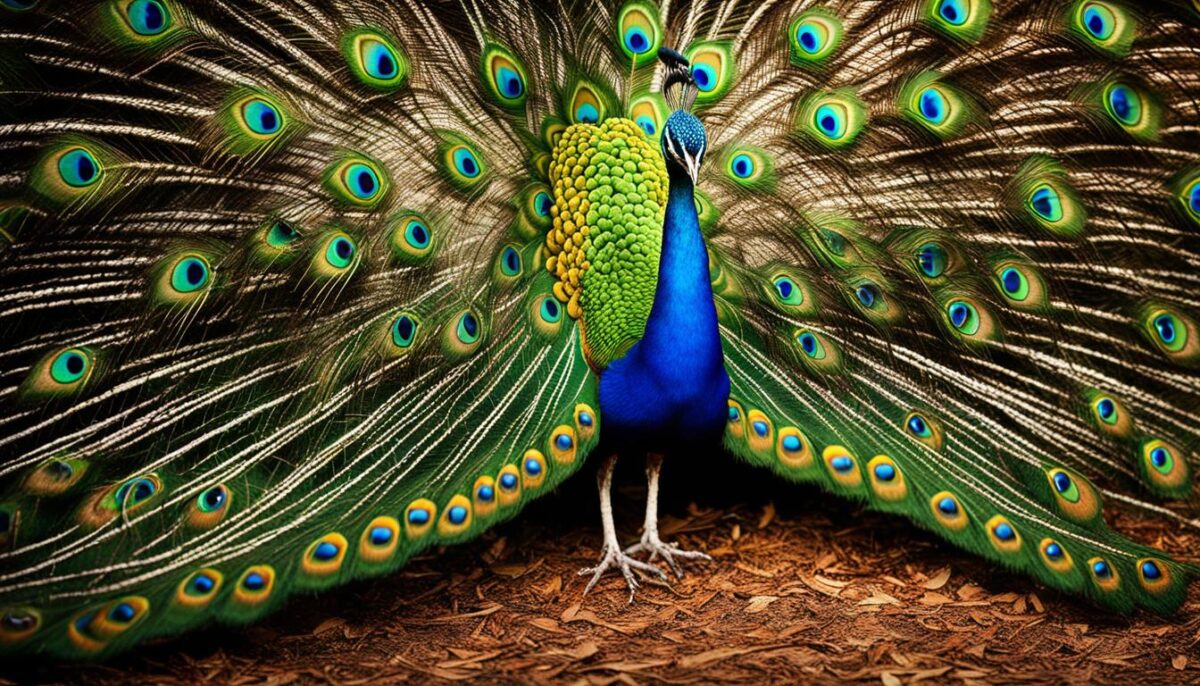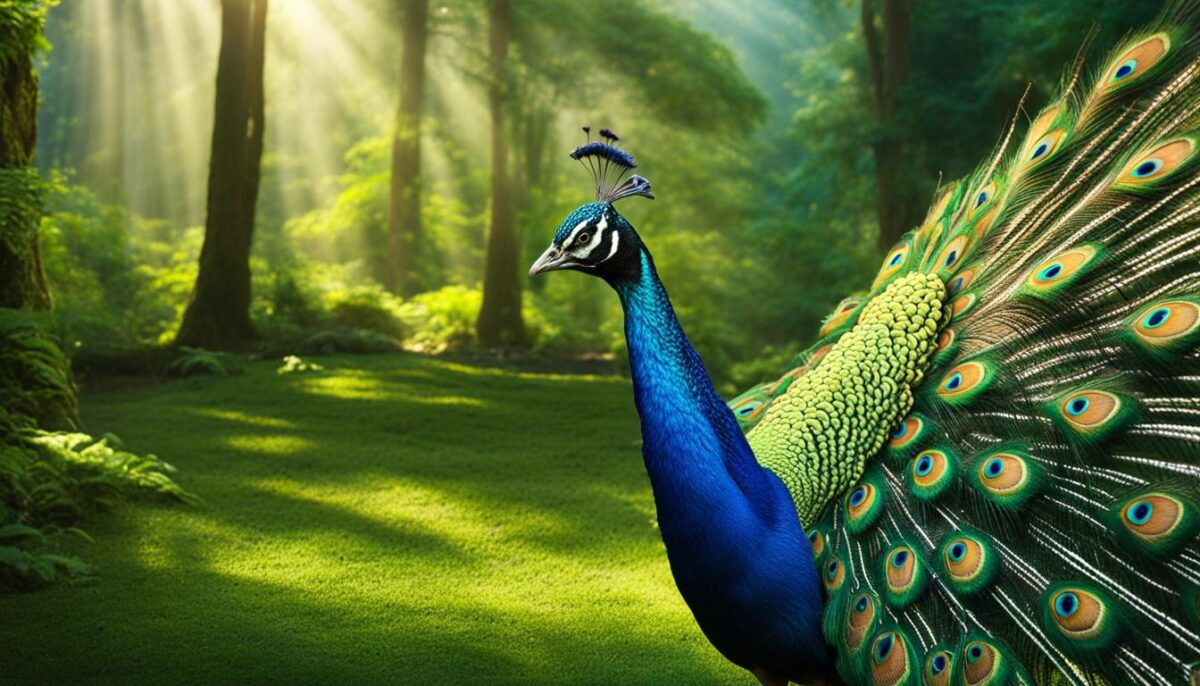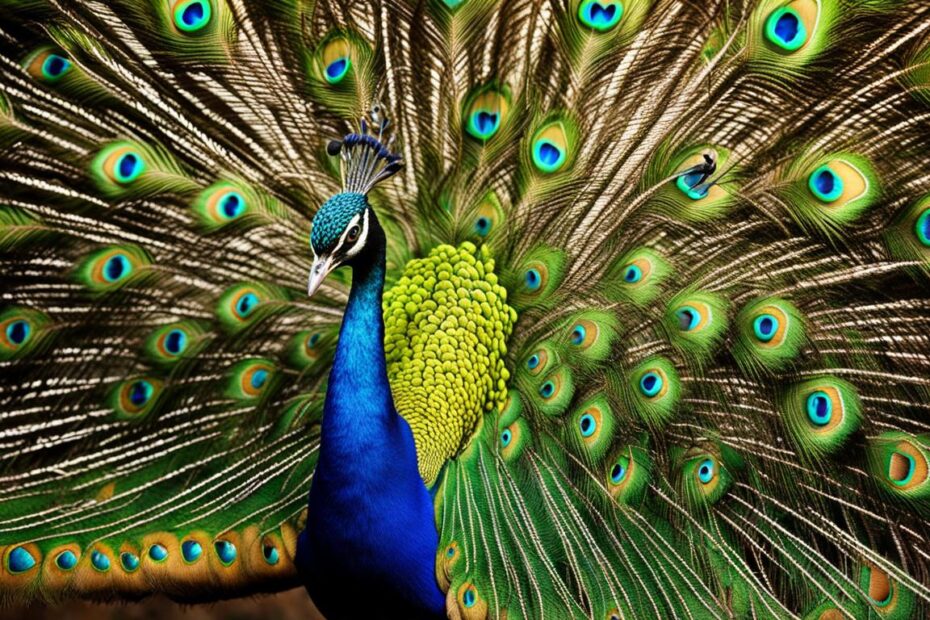Peacocks possess a unique defense mechanism that revolves around their vibrant plumage. This adaptation showcases their adaptive behavior and deterrent tactics, allowing them to navigate their environment with remarkable efficiency. Through an in-depth analysis of the peacock defense mechanism, we can unravel the intricate strategies employed by these magnificent birds to ensure their survival.
Key Takeaways:
- Peacocks employ their vibrant plumage as a defense mechanism to deter potential threats.
- The intricate coloration and patterns of their feathers provide camouflage and aid in protective behavior.
- Peacock deterrent tactics involve threat displays and group behavior to intimidate predators.
- Understanding the peacock defense mechanism offers valuable insights into their adaptive behavior.
- The survival strategies of peacocks are essential for ensuring their continued presence in ecosystems.
The Evolution of Peacock Plumage
The extravagant plumage of male peacocks has long fascinated scientists and has been the subject of extensive study. Charles Darwin suggested that the peacock’s train evolved through sexual selection, as females prefer males with more exaggerated secondary sexual characteristics. However, there is ongoing debate about the functions of the elaborate iridescent coloration and large train of peacocks. Some researchers propose that these features serve as an aposematic display to intimidate predators and rivals. Others argue that the train is a result of runaway sexual selection or sensory bias. Additionally, the train may act as an honest signal of the male’s fitness, indicating that he can successfully survive with such conspicuous structures. Overall, the evolution of peacock plumage is believed to be a combination of sexual selection, natural selection, and multiple causality for female choice.
To better understand the evolution of peacock plumage, let’s explore the various hypotheses proposed by researchers. The first hypothesis suggests that the train’s extravagant size and vibrancy serve as a visual deterrent to predators. The theory behind this is that the bright colors and intricate patterns of the feathers signal that the peacock is toxic, unpalatable, or capable of defending itself. By advertising its potential danger, the peacock is less likely to be targeted by predators, increasing its chances of survival and reproductive success.
Another hypothesis revolves around the idea of sexual selection. According to this theory, female peahens prefer males with more elaborate and visually striking plumage. By choosing mates with these characteristics, females ensure that their offspring inherit the genes responsible for the development of such extravagant traits. This hypothesis suggests that the evolution of peacock plumage is driven primarily by female choice and the desire to produce offspring with greater attractiveness and fitness.
| Summary of Hypotheses on the Evolution of Peacock Plumage | |
|---|---|
| Hypothesis 1 | The peacock’s plumage serves as an aposematic display to deter predators. |
| Hypothesis 2 | The evolution of peacock plumage is driven by sexual selection and female choice. |
The vibrant plumage of male peacocks is a result of complex evolutionary processes involving sexual selection, predator deterrence, and honest signaling of fitness. Understanding the multiple causality behind the evolution of peacock plumage provides valuable insights into the survival strategies and adaptations of this iconic species.
The Science Behind Peacock Plumage
Peacock plumage is not just visually stunning, but it also has a unique scientific aspect. The vibrant colors of a peacock’s plumage are not primarily pigments but are instead produced by structural coloration. The feathers contain thin-film interference structures within their barbules, which cause the colors to change with the angle of view. This iridescence is created by optical interference based on the periodic nanostructures of the barbules. It’s fascinating to learn that the extravagant colors we see are a result of intricate structural features rather than simple pigmentation.
Another interesting aspect is the presence of intricate eye patterns and T-shaped feathers in peacock plumage. The uniform spacing of the eyes in the feathers and the unique structure of the individual eye feathers add to the overall beauty and complexity of the plumage. These structural features, combined with the elaborate fan formation and vibrant coloration, contribute to the protective behavior and camouflage techniques of peacocks. Their plumage is designed to captivate not only potential mates but also to confuse and startle predators, helping the peacocks hide and protect themselves in their natural habitat.
| Structural Features of Peacock Plumage | Function |
|---|---|
| Intricate eye patterns | Camouflage and visual deception |
| T-shaped feathers | Enhance overall visual display |
| Thin-film interference structures | Produce vibrant and iridescent colors |
The vibrant colors of a peacock’s plumage are not just for show, but they serve a dual purpose of attracting mates and providing protection. Through structural coloration and intricate patterns, peacocks have evolved a unique camouflage technique that helps them blend into their surroundings and confuse predators. The optical interference structures in their feathers create an ever-changing display of colors that mesmerizes and confounds both potential mates and would-be attackers. The beauty and complexity of peacock plumage are truly a marvel of nature.
The science behind peacock plumage not only adds to our understanding of these magnificent birds but also highlights the incredible adaptations that have evolved over time. Through their vibrant and structurally complex plumage, peacocks have mastered the art of blending in and standing out simultaneously. This combination of camouflage and visual display serves as a testament to the intricate and fascinating world of evolutionary biology.
Courtship Displays and Mating Behavior
Male peacocks employ a range of intimidation tactics during their courtship displays to attract female peahens. A key element of their approach is the elaborate plumage that they proudly display. By fanning out their feathers, male peacocks create a visually striking spectacle, with the prominent eyespots on their train catching the attention of potential mates. These displays are believed to serve multiple purposes, including intimidating rival males and signaling the male’s genetic fitness to the female peahen.
The male peacock strategically positions himself to maximize the iridescence of his train in the sunlight, enhancing the visual impact of his display. This combination of vibrant colors and intricate patterns is thought to convey a message of confidence, dominance, and attractiveness to the female. The female peahen evaluates the male’s display, assessing the number and arrangement of eyespots, as well as the overall size and symmetry of the train, to determine the male’s genetic quality and suitability as a mate.
“The courtship ritual involves the male shaking his feathers and making specific calls to signal his readiness to mate.”
Throughout the courtship ritual, the male peacock engages in specific behaviors, such as shaking his feathers and making distinct calls, to demonstrate his readiness to mate. These behaviors, combined with the visual spectacle of the male’s display, play a critical role in attracting the attention and interest of the female peahen. If the female finds the male’s display and behavior satisfactory, she may choose to interact with him, leading to the initiation of the mating process.
Peacock Courtship Display
The courtship display of male peacocks involves a range of visually stunning behaviors and features:
- Fanning out the feathers in a fan-like formation.
- Accentuating the eyespots on the train.
- Orienting the feathers to maximize iridescence in the sunlight.
- Shaking the feathers and making specific calls.

| Behavior | Function |
|---|---|
| Fanning out the feathers in a fan-like formation | Increases the visual impact of the display, showcasing the train’s eyespots and intricate patterns. |
| Accentuating the eyespots on the train | Draws the attention of the female peahen and signals the male’s genetic fitness. |
| Orienting the feathers to maximize iridescence in the sunlight | Enhances the vibrancy of the plumage, making it more visually striking. |
| Shaking the feathers and making specific calls | Signals the male’s readiness to mate and further captures the female’s attention. |
The Functions of the Peacock’s Train
The functions of the peacock’s train have long been a subject of scientific debate. One hypothesis suggests that the train serves as an aposematic display to intimidate predators and rivals. The size and brilliance of the plumage make the peacock more visible to potential threats, but it may also signal the male’s strength and ability to survive with such a conspicuous structure. Another hypothesis proposes that the train is primarily a result of sexual selection, as females prefer males with more elaborate and visually striking plumage. The train may act as an honest signal of the male’s genetic fitness, as less-fit males would struggle to survive with such a handicap.
To better understand the functions of the peacock’s train, researchers have conducted studies on peacock defensive behavior and self-defense techniques. These studies have revealed that the train plays a crucial role in predator deterrence, mate attraction, and honest signaling of fitness. The vibrant colors and intricate patterns of the feathers may visually indicate that the peacock is a potential threat, causing predators to think twice before attacking. The train also allows females to assess the male’s genetic quality and choose the most suitable mate for reproduction.
Overall, the functions of the peacock’s train likely involve a combination of predator deterrence, mate attraction, and honest signaling of fitness. The train serves as a visually striking display that not only captures the attention of females but also warns potential predators of the peacock’s presence and defensive capabilities. Through the evolution of their elaborate plumage, peacocks have developed a remarkable adaptive behavior that contributes to their survival and reproductive success in the wild.
| Function | Description |
|---|---|
| Predator Deterrence | The train’s size and brilliance make the peacock more visible to potential threats, deterring predators from attacking. |
| Mate Attraction | The elaborate plumage attracts female peahens, who use the train’s size, symmetry, and arrangement of eyespots to assess the male’s genetic quality. |
| Honest Signaling of Fitness | The train acts as an honest signal of the male’s genetic fitness, indicating his ability to survive with such a conspicuous and burdensome structure. |
Peafowl as Aposematic Species
Peafowl, with their vibrant plumage and elaborate displays, are considered aposematic species. Aposematism is a defense mechanism in which organisms use conspicuous signals to deter potential predators. In the case of peafowl, their train and iridescent plumage serve as visual warnings to predators, signaling that the birds are toxic, unpalatable, or capable of defending themselves. The bright colors and intricate patterns of their feathers visually indicate that the peafowl are potential threats, causing predators to think twice before attacking.
This aposematic behavior helps ensure the survival of the peafowl by deterring potential predators and increasing their chances of survival. By displaying their vibrant plumage and intricate patterns, peafowl communicate their unpalatability or toxicity, warning predators that they are not suitable prey. This visual deterrent can be highly effective in deterring predators and reducing the risk of predation.
The aposematic behavior of peafowl is an evolutionary adaptation that has been shaped by the need to protect themselves from predators. Their vibrant plumage serves as a visual signal that potential predators recognize and associate with unpalatability or toxicity. By relying on this defense mechanism, peafowl are able to survive and thrive in various environments despite the presence of predators.

Peafowl’s aposematic behavior is a fascinating example of how animals have evolved to protect themselves from predators. The vibrant plumage and elaborate displays of peafowl serve as an effective deterrent, signaling to predators that they are not suitable prey. By utilizing this adaptive behavior, peafowl are able to increase their chances of survival in the wild and maintain their populations for future generations to admire and study.
Peafowl Threat Response and Adaptations
Peafowl have developed various adaptive behaviors and threat responses to protect themselves from predators. When faced with a potential threat, peafowl utilize a combination of visual displays, vocalizations, and physical postures to startle and deter predators. Their vibrant plumage and intricate patterns play a crucial role in these threat responses, contributing to their survival in the wild.
One of the main threat responses exhibited by peafowl is the display of their plumage. When a potential threat is detected, these majestic birds raise their tail feathers in a fan-like formation, showcasing the vibrant colors and intricate eye patterns. This visually striking display is intended to startle and intimidate predators, making the peafowl appear larger and more conspicuous. The combination of bold colors and eye-catching patterns may also confuse or startle predators, giving the peafowl an opportunity to escape.
Alongside their visual displays, peafowl emit threatening calls to further deter predators. These calls serve as a warning signal, alerting other members of the group to the presence of a potential threat. The coordinated vocalizations not only communicate the presence of danger but also contribute to the overall defense mechanism of the peafowl.
| Threat Response | Explanation |
|---|---|
| Visual Displays | Peafowl raise their tail feathers in a fan-like formation, showcasing vibrant colors and intricate eye patterns to startle and intimidate predators. |
| Vocalizations | Peafowl emit threatening calls to warn other members of the group and communicate the presence of potential threats. |
| Physical Postures | In response to threats, peafowl may adopt specific physical postures to appear more formidable and increase their chances of survival. |
In addition to their threat responses, peafowl possess keen eyesight and hearing, allowing them to detect potential threats from a distance. This heightened sensory perception enables them to respond promptly and appropriately to ensure their safety. By incorporating a combination of visual displays, vocalizations, and physical postures, peafowl have evolved robust adaptive behaviors that contribute to their protection and survival in their natural habitat.
Peacock Plumage and Communication
The vibrant plumage of male peacocks not only serves as a visual display for mating purposes but also plays a role in communication. By displaying their feathers in a specific manner, peacocks can communicate various messages to other members of their species. The size, symmetry, and arrangement of the eyespots, as well as the overall appearance of the train, can convey information about the male’s fitness, dominance, and genetic quality. Other peacocks can assess these visual cues and adjust their behavior accordingly, influencing social dynamics and hierarchy within the group. This visual communication through plumage is an important aspect of peacock behavior and serves multiple purposes in their social interactions.
“The vibrant plumage of male peacocks is not just a display of beauty but also a form of communication within the species. The arrangement and quality of their feathers convey vital information about their genetic fitness and dominance. This visual language allows peacocks to establish social hierarchy and influence the behavior of other individuals in the group.”
Peacocks use their plumage to attract mates, intimidate rivals, and assert dominance. Through their vibrant display and specific patterns, they communicate their intentions and establish their place within the social structure. This visual communication is a powerful tool that allows peacocks to navigate their social interactions and ensure the reproductive success of the species.
The Language of Plumage
The peacock’s train, with its intricate patterns and vibrant colors, acts as a visual language that other peacocks can interpret. The size and symmetry of the eyespots, as well as the overall appearance of the plumage, indicate the strength and genetic quality of the male. Peacocks that display a larger and more symmetrical train are seen as more desirable mates, as they are perceived to have better genes and a higher chance of survival. This information is crucial for peahens in choosing their partners and ensuring the successful transmission of genetic traits to the next generation.
| Plumage Feature | Meaning |
|---|---|
| Large train with symmetrical eyespots | Indicates genetic fitness, dominance |
| Small or asymmetrical train | Lower genetic quality, lower social status |
| Brilliant coloration | Suggests ability to survive with conspicuous features |
This visual language goes beyond mere aesthetics and serves as a vital aspect of peacock behavior. By understanding and interpreting the messages conveyed through plumage, peacocks can navigate their complex social dynamics, establish dominance, and secure mating opportunities within their population.
Peafowl Group Behavior
Peafowl, known for their vibrant plumage and intricate displays, also exhibit fascinating group behaviors that contribute to their survival and protection. These behaviors are essential for fostering cooperation, sharing information, and coordinating defensive responses within the group. When faced with a potential threat, peafowl demonstrate remarkable adaptability and collective defense mechanisms.
One of the key group behaviors of peafowl is their tendency to gather in groups called an ostentation or a muster. In these groups, peafowl collaborate to look out for each other’s safety and well-being. They utilize alarm calls to alert other members of the group about potential threats, signaling them to display their plumage for defense. By coordinating their responses in this way, peafowl enhance their collective protection and increase their chances of survival in the face of predation.
Peafowl group behavior is not limited to defensive strategies alone. These social birds also engage in communal activities such as foraging, roosting, and even raising their young together. By engaging in these activities as a group, peafowl can effectively share resources, provide protection, and improve their overall chances of survival. The strong social bonds forged through group behavior play a crucial role in their adaptive strategies and ensure the cohesion of the peafowl community.
| Advantages of Peafowl Group Behavior | Examples |
|---|---|
| Increased protection against predators | Coordinated defense displays and alarm calls |
| Enhanced resource sharing | Communal foraging and roosting |
| Improved reproductive success | Group nest protection and rearing of young |
Peafowl group behavior is a remarkable example of adaptive behavior in response to their environment. By working together, these birds enhance their survival prospects and ensure the continuation of their species. Understanding the intricacies of peafowl group behavior provides valuable insights into the collective intelligence and cooperative strategies employed by these magnificent birds.
Peacock Conservation and Human Interactions
Peacocks are not only beautiful creatures but also play a vital role in our ecosystems. However, their populations have faced numerous challenges due to human interactions and habitat loss. The hunting of peafowl for their feathers, meat, and decorative purposes has led to a decline in their numbers in certain regions. Additionally, urbanization and deforestation have resulted in the loss of their natural habitats, further threatening their survival.
Efforts are being made to conserve and protect peacock populations through various means. The establishment of protected areas and wildlife sanctuaries is crucial for creating safe havens where peafowl can thrive. These areas provide the necessary habitat and resources for peacocks to live and reproduce. Furthermore, raising awareness about peacock conservation is essential in promoting their preservation. Through education and outreach programs, people can learn about the importance of peafowl in our ecosystems and the need to protect them.

Legal protections also play a significant role in safeguarding peacock populations. Implementing laws and regulations that prohibit the hunting and trade of peafowl can help curb their exploitation. Additionally, community engagement is vital in promoting the conservation of peacocks. Involving local communities in conservation initiatives fosters a sense of ownership and responsibility towards protecting these magnificent birds.
It is crucial to strike a balance between human interactions and the conservation of peacocks. By respecting their habitats, refraining from hunting, and supporting conservation efforts, we can ensure the long-term survival of these iconic species. Peacocks bring joy and beauty to our world, and it is our responsibility to protect them for future generations to admire and appreciate.
The Importance of Peacock Conservation
Peacock populations play a crucial role in maintaining the balance of ecosystems. As seed dispersers, they help in the regeneration of plant species by consuming and spreading seeds. By protecting peafowl, we are also safeguarding the ecological diversity and stability of their habitats. Additionally, peacocks contribute to the tourism industry, attracting visitors who are fascinated by their beauty and unique behaviors.
Human-Peacock Interactions
Peafowl have become a familiar sight in urban and suburban areas, often coexisting with humans. While this can be a positive aspect, it also poses challenges. The presence of peacocks can lead to conflicts, such as damage to property, noise complaints, and interactions with pets. Finding ways to manage these interactions and mitigate conflicts is essential to ensure peaceful coexistence between humans and peafowl.
The Way Forward
Conservation efforts, legal protections, and community involvement are vital in ensuring the survival of peacocks. By working together, we can preserve their natural habitats, prevent illegal hunting, and raise awareness about the importance of peacock conservation. Only through collective action can we secure a future where peafowl continue to grace our landscapes and captivate our hearts.
Conclusion
The peacock defense mechanism is a remarkable adaptation that enables peacocks to survive and thrive in their natural environment. Their vibrant plumage, threat displays, and group behavior work together to deter predators and ensure their survival. Through the evolution of elaborate plumage, peacocks have developed effective strategies for attracting mates, intimidating rivals, and responding to potential threats.
The structural coloration and intricate patterns of their feathers contribute to their defense mechanism by providing camouflage, communication, and protection. Peacocks utilize their feathers as a means of both attracting mates and deterring predators. The vibrant colors and intricate eye patterns of their feathers serve as a visual signal to potential predators, warning them of the peacock’s toxic or unpalatable nature.
While challenges such as habitat loss and human interactions pose threats to peacock populations, conservation efforts and increased awareness can help protect these iconic birds. Understanding the peacock defense mechanism provides valuable insights into their adaptive behaviors and survival strategies. By preserving their natural habitats and promoting conservation efforts, we can ensure the long-term survival of peacocks and continue to admire and study their remarkable defense mechanisms.
FAQ
What is the purpose of a peacock’s vibrant plumage?
The vibrant plumage of male peacocks serves multiple purposes, including attracting mates and intimidating rivals.
How do peacocks use their feathers to deter predators?
Peacocks display their feathers in a fan-like formation and emit threatening calls to startle and intimidate predators.
What is the function of the eyespots on a peacock’s train?
The eyespots on a peacock’s train convey information about the male’s fitness and genetic quality to potential mates.
Do peacocks use their plumage for communication?
Yes, peacocks use their plumage as a form of visual communication to convey messages to other members of their species.
How do peafowl protect themselves from predators?
Peafowl display threat behaviors, such as raising their tail feathers and emitting alarm calls, to startle and deter predators.
Are peacocks considered aposematic species?
Yes, the vibrant colors and patterns of a peacock’s plumage may serve as a visual warning to predators, indicating that the bird is unpalatable or toxic.
What conservation efforts are in place for peacocks?
Conservation efforts for peacocks include the establishment of protected areas, wildlife sanctuaries, and awareness campaigns to promote their conservation.
How do peacocks communicate within their groups?
Peacocks communicate within their groups through visual displays, alarm calls, and coordinated defensive responses.
What are the threats to peacock populations?
Peacock populations are threatened by hunting, habitat loss due to urbanization and deforestation, and human interactions.
Do peacocks have a specific defense mechanism?
Yes, peacocks have a unique defense mechanism that combines vibrant plumage, threat displays, and group behavior to deter predators and ensure survival.


